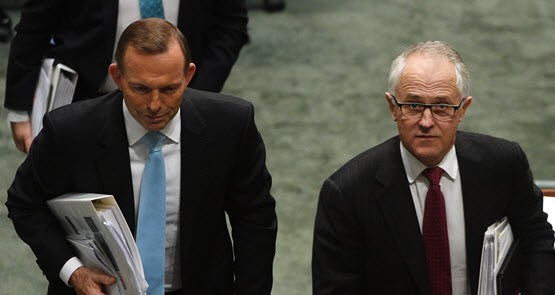
There is an argument to be made that the renewable energy industry in Australia was better off when Tony Abbott was prime minister. At least it knew then why the government was trying to destroy it.
Under Abbott, the message was clear and unequivocal: we don’t want you; we don’t like the way you look; you’re causing health problems for people; and your technology doesn’t work anyway. Besides, coal is good for humanity.
The message was clear from top to bottom. Abbott and his treasurer found wind turbines to be offensive, his chief business adviser thought climate science was a giant hoax, and the pro-nuclear head of his review into renewable energy said wind and solar were not useful. Junior MPs and ministers proved echo-chambers for the myth-making of anti-wind social media sites. There was never any doubt as to that government’s intentions.
Under the leadership of Malcolm Turnbull, the rhetoric has (mostly) changed; the gratuitous insults and personal prejudice are (largely) gone, although coal is still considered to be good for humanity and to solve hunger. But policy has not changed, and the industry has little to show for the change in leadership.
The Turnbull government has begun 2016 in the same way that the Abbott government started 2014 and 2015 — with legislation on the table that calls for the dismantling of the government’s key agencies: the Clean Energy Finance Corporation, the Australian Renewable Energy Agency and the Climate Change Authority.
Greens Senator Larissa Waters highlighted the move on her Facebook page on Monday and wondered why.
Like Abbott, Turnbull has allowed the terms of the appointed board members of ARENA to expire, meaning that the supposedly independent agency is now governed solely by the secretary of Greg Hunt’s Environment Department. The board of the CCA has been largely replaced by advisers and ex-Coalition MPs sympathetic to the Coalition’s approach to climate change.
Like Abbott, Turnbull is hiding behind a climate policy that he contemptuously dismissed as a “fig leaf”. Despite signing up to the Paris climate agreement and its ambitious target of capping temperatures “well below” 2 degrees, and possibly as low as 1.5 degrees, the Coalition continues a policy plan that assumes temperature gains of 4 degrees.
It has offered a target of 26-28% reductions in emissions (below 2000 levels) by 2030. This is dismissed as inadequate by all independent assessments, yet it has no credible policy to reach even this modest goal.
The government will reach its 2020 target of a 5% reduction thanks to an “accounting trick” using surplus credits from the Kyoto Protocol, but its emissions are actually forecast to rise to record levels around the same time and will not likely peak until 2030.
Funding for Direct Action’s Emissions Reduction Fund has not been renewed, according to Finance Minister Mathias Cormann, and will likely expire this year. Its safeguards mechanism imposes no restrictions on big emitters.
A fig leaf indeed. Little wonder, then, that the Grantham Institute in the UK scored Australia a zero on “high level policy vision”. Australia ranks well on public support for climate and clean energy policies, and for the institutions put in place. But it is these very institutions that the Coalition still threatens to remove.
The result is confusion, concern and dismay. Despite all the talk of the “innovation economy”, the large-scale renewable energy target remains at a standstill, without a single wind farm or solar farm commissioned or built since the Coalition took power in September 2013.
Distributed generation — rooftop solar and battery storage — remain popular with homes and businesses, but state and privately owned utilities are running roughshod, amending tariffs and imposing rules despite the best attempts of consumer groups and others.
The only large-scale projects to get the go-ahead are those funded under the ACT government’s reverse auction program, a testament to what sound and clear policy can achieve. Other projects such as the big solar farms built in NSW were instigated by Labor and funded by the very agencies that the Coalition wants to dismantle.
There are signs that some construction will finally begin. State-owned utilities such as Ergon and Synergy have been tendering for projects, and local and state governments such as Melbourne City Council and the South Australian government have also tendered to ensure that their own energy needs are met with renewable energy.
NSW has done the same for its proposed Metro Rail project, and one privately owned utility, Alinta Energy, has also issued a tender.
But even if the drought is broken, there is little chance that the industry can get anywhere near the construction needed to avoid a shortfall in the RET, and therefore penalty payments being imposed on utilities, and ultimately the consumer.
Green Energy Markets says 4400MW of new projects needs to be commissioned this year to ensure that even the reduced target of 33,000GWh is to be met on time.
In the last four months, just 8MW of renewables was commissioned, despite renewable energy certificates soaring to record levels of $77/MWh. The obligated parties and the financiers simply do not believe that the policy is solid.
This is what the Grantham Institute refers to in the lack of high-level or long-term vision. The government’s climate policy effectively ends at the end of this year, and the RET has no visibility beyond 2020. The industry is trying to sound positive and hopeful, but it is becoming increasingly exasperated.
Some may argue that this is the inherent weakness of the Paris climate deal, which imposes no legal penalties on governments that do not meet their targets. But to do so would be to misunderstand what is happening beyond the insular, fossil-fueled thinking of the Australian economy.
The reason agreement was reached in Paris — apart from the astute diplomacy of the French — was that technology presents no major hurdle or added costs. Australia’s position assumes business as usual for its fossil fuel exports, but the biggest economies are finding that they have cheaper, home-grown alternatives.
India’s own energy minister last month conceded that large-scale solar was cheaper than coal power. That should give a pretty big clue about where that country will be heading in the short, medium and long term. The capital markets are already moving, and the Paris deal will add to that momentum.
Australia was a party to the Paris deal, and even climbed aboard the Coalition of Ambition after the deal had been approved to much acclaim. But its support appeared begrudging. Even in Paris it baulked at the removal of fossil fuel subsidies, and continued to argue that coal was key to stop hunger.
So while the likes of Ross Garnaut talk of the enormous opportunities if the country were to take advantage of its renewable resources and its know-how, Australia insists on playing dumb. For what purpose, other than the satisfaction of ideological and vested interests, is not at all clear.









Bring on a Double Dissolution Prime Minister! Giles article sums up the Electorates opportunity to flood public awareness of (not only the PM’s lack of vision and agility as evidenced by his NBN debacle) . . but how completely bereft this PM’s understanding is on the vital issue of Climate Change and the simply massive potential associated with Renewable Energy.
1.5 million homes x say 3 voters per household plus solar business premises / employees = something much more than potential. They are a reality, so bring it on PM.
graybul,while Giles may sum up the sorts of economical insanity which could be used by Politicians and others to promote absurd policies, it also shows how bereft of any comprehension are the fellow-travelling devotees of sacred beliefs.
Heaven help the Planet if they were to succeed at an international level.
To complain that a govt functionary identifies nuclear as better than renewables is an action defending the renewables industry, not the greenhouse. If you must presume to do so, you surely owe it to us to disclose your involvement in the renewables industry.
The Paris Agreement is for “zero net emissions”, which only nuclear energy can achieve. Renewables will always require gas backup, which is at most half that distance. And in the wrong direction.
I wonder what Sri Adani thinks of India’s own energy minister last month conceded that large-scale solar was cheaper than coal power?
Is gNormless ailing? He has posted without his moth eaten phrase ‘Crikey Commissariat’ though still needs to woRk on tHe raNdoM capiTalS proBLem.
The reason we use a capital letter with Giles is that it’s his name and not a classification. With Politicians it’s a standard way of showing (to the moderately educated of course) that we’re referring to occupants of an Office rather than merely those involved in political activities such as those involved in membership of, say, a basket weaving group. I suggest you phone a (moderately literate) friend if you still can’t understand why a capital letter might be used with the third example in the original Post.
P.S. Someone who like courageous anonymous AR who regurgitates infantile variations of names for those who don’t share his quaint belief structures requires serious help from ANYONE he knows.